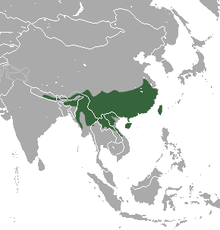Chinese pangolin
| Chinese pangolin | |
|---|---|
 |
|
| Scientific classification | |
| Kingdom: | Animalia |
| Phylum: | Chordata |
| Class: | Mammalia |
| Order: | Pholidota |
| Family: | Manidae |
| Genus: | Manis |
| Species: | M. pentadactyla |
| Binomial name | |
|
Manis pentadactyla Linnaeus, 1758 |
|
 |
|
| Chinese pangolin range | |
The Chinese pangolin (Manis pentadactyla) is a pangolin found in northern India, Nepal, Bhutan, Bangladesh, Myanmar, northern Indochina, through most of Taiwan, and southern China (including the islands of Hainan). The Chinese pangolin is one of eight species of pangolins. Although these species are difficult to observe due to their elusive and solitary habits, all eight are believed to be on the decline. Asian pangolin species, especially the Chinese pangolin and the Sunda pangolin, are the most endangered of all the pangolin species. The IUCN reports that the number of Chinese pangolins has declined greatly over the past 15 years. Despite being listed as critically endangered by the IUCN and being protected by CITES, poaching continues to be the main cause of their decline in numbers. Deforestation has also contributed to their depletion.
The Chinese pangolin has the appearance of a scaly anteater. Its head and body measure about 40–58 cm and its tail measures about 25–38 cm (9.8–15.0 in). A mature Chinese pangolin weighs from 2 to 7 kilograms (4.4 to 15.4 lb). It has 18 rows of overlapping scales accompanied by hair, a rare combination in mammals. It has a small, narrow mouth and a little, pointed head. Also its claws grow in as it grows older. The female gives birth to a single offspring at a time.
A newborn pangolin weighs about 93 g (3.3 oz), its length is about 45 cm (18 in). The Chinese pangolin reproduces in April and May when the weather warms. The young also have scales; however, they remain very soft for at least two days, then harden. Although the young pangolin can walk on its first day, the mother carries it on her back or tail. If the mother feels threatened, she immediately folds her baby onto her belly with the help of her tail. Male pangolins have been observed allowing the female and baby to share his burrow.
Chinese pangolins are rather secretive, nocturnal creatures. They move very slowly and are known for their nonaggressive behavior. Their hard scales work as a protective cover from predators, and when they feel threatened, they curl themselves into balls. For further defense, they can climb trees, although this is uncommon.
...
Wikipedia

